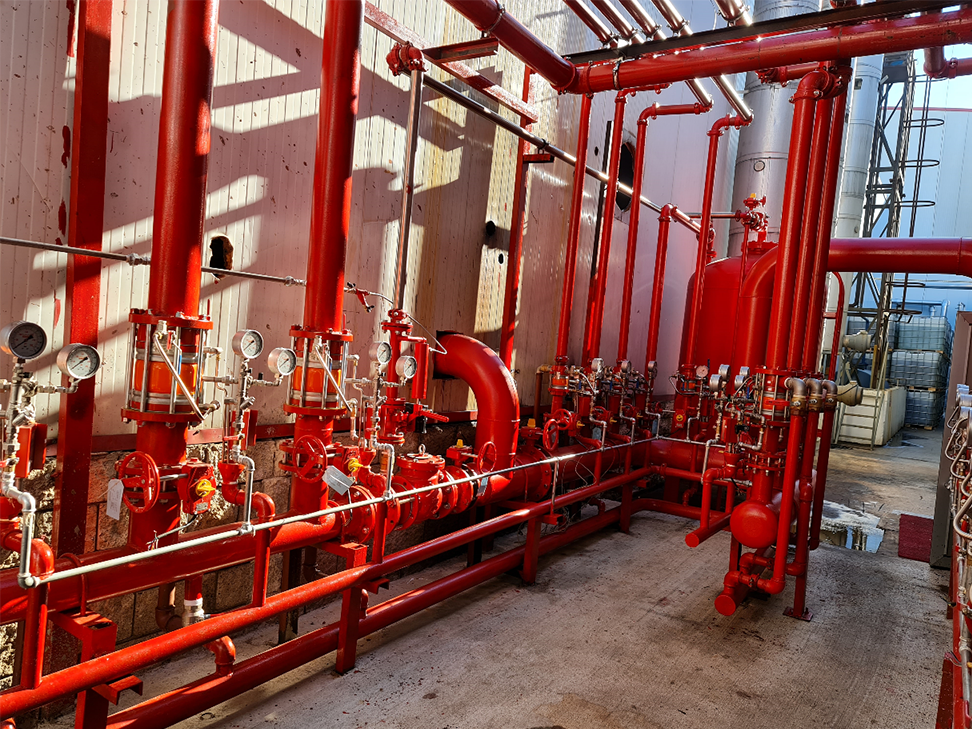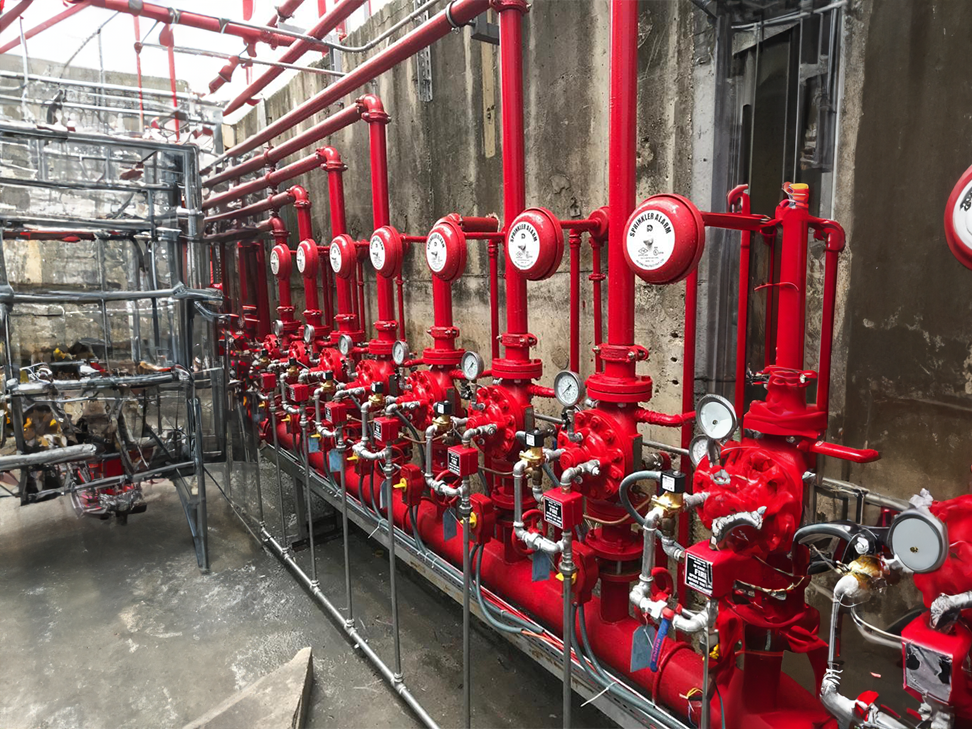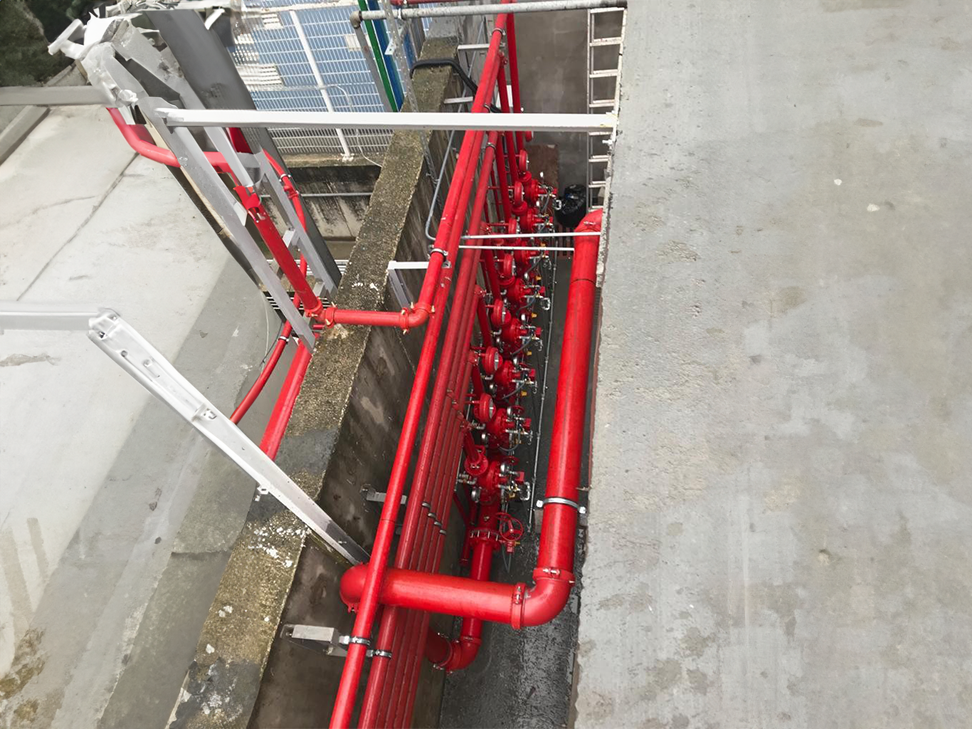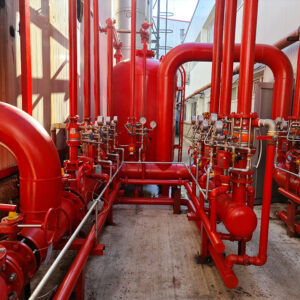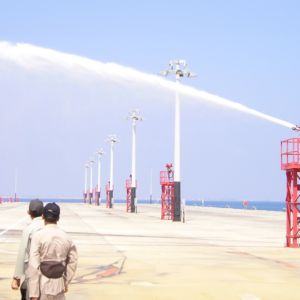1.- FOAM SPRİNKLER SYSTEMS
A sprinkler system is a system in which discharge heads are sealed with a breakable bulb or a fusible link that breaks at a predetermined temperature. The discharge head also acts as a detector, and only the activated heads discharges water, ensuring that foam is applied directly to the fire area and minimizing water damage.
Such systems are becoming increasingly popular in flammable liquid or general purpose warehouses, process plants and material handling-storage-delivery areas. They are particularly useful in large areas that can be protected by a single system operating exactly where it is needed. It can also be used as a combined detection/protection system in smaller areas such as engine rooms and generator enclosures
Since sprinkler heads do not aspirate, one of the film-forming foam concentrates should be used. Alcohol and solvent resistant (AR) derivative foam is needed in areas where chemicals such as polar solvents and alcohol can be stored.
In the past, the main problem with such systems was the difficulty of proper proportioning. Since it was not possible to know how many discharge heads would initially operate, the actual flow rate in any given event could not be accurately predicted. It is therefore vital to have a proportioning system that can cope with an extremely wide range of possible flows. A limited number of manufacturers have developed extremely high quality and reliable products with a wide operating range. A wide operating range proportioner allows users of foam sprinklers to be confident that the system will operate correctly under all possible operating conditions.
A considerable amount of work is being carried out by many manufacturers and insurance companies to make simple, fast and effective protection, especially for in-rack protection of flammable liquid warehouses and high-bay storage areas. Design standards are constantly changing due to ongoing research studies.
AKSAY Yangın is in a position to design fire protection systems by constantly following the relevant standards, following the new productions and application experiences of the manufacturers and obtaining up-to-date information, and is in a position to commit to the effective operation of the systems it designs by performing the installation and function tests (often one-to-one discharge test).
t should also be noted that the addition of film-forming foams to a water supply enhances the wetting effect by reducing the surface tension of the water and allowing it to penetrate more and faster into solid combustibles. Tests have shown that fires can be extinguished faster using this mechanism, thus ensuring that water damage is kept to a minimum.
2.- DELUGE LOW and MEDIUM EXPANSION FOAM SYSTEMS
The Deluge Foam System works on the principle that all discharge heads operate simultaneously. Properly designed foam sprinkler systems provide effective protection against indoor and outdoor risks where flammable liquids can spill. Typical risks that can be protected are road and rail loading areas, Tanker Filling, aircraft hangars, horizontal and vertical fuel storage tanks, pump rooms and chemical process plants.
Deluge Foam Systems can provide an even, homogeneous foam distribution for fast fire extinguishing as well as safe and accurate fire control. They can also provide a valuable cooling effect to structures within the fire area or protect against heat radiation from adjacent fire areas. Installed together with detection systems. By utilizing the variety of detectors and their fast response times, the systems can be activated very quickly. Due to this feature, the systems provide effective extinguishing. At the same time, the system can be activated manually via the Deluge Valve Station and the manual activation process can be moved to the risky area. Thus, without waiting for an impulse from the detection system, field personnel can activate the system on initiative when necessary.
The nozzles used can be non-aspirated or aspirated. Aspirated nozzles generally provide better foam quality but will be more expensive. However, the price of nozzles is usually not a very important factor in the total cost of an installed system. When using non-aspirating nozzles, a film-forming foam type must be selected.
Especially in areas with horizontal or vertical equipment, it is not possible to provide protection only at ceiling level. For such risks, a variety of nozzles with different discharge patterns are available for elevated or ground level installation. It is necessary to support with Medium Expansion Foam Pourers, especially at points where nozzles at ceiling level cannot quickly cover under obstacles on the floor.
3.- DELUGE HIGH EXPANSION (HI-EX) FOAM SYSTEMS
High expansion concentrates contain substances that allow water to be transported to inaccessible places. They are very effective in confined spaces where they are used to submerge the fire and exclude the air needed to sustain combustion. Their relatively low water content has a great cooling effect on the solid surface and allows the fire to be extinguished. Some destruction of the foam by the fire will occur, which is compensated by an additional application rate.
High expansion foam provides effective extinguishing of areas such as cable tunnels, underground storage facilities, basements, ship hold, warehouses and airplane hangars by filling to the specified height within the specified time. In addition to being used in liquid fires, it is also very effective in fires of flammable solid materials such as paper and wood. In-depth fires can be suppressed for a long time with High Expansion (Hi-EX) foam systems and the wetting effect of the foam penetrates deeper than ordinary water.
High expansion foams are also used for other purposes:
- a) Providing an isolation barrier to protect exposed materials or structures not directly involved in the incident
- b) Provide suppression of vapors from toxic or flammable spills
High-expansion foam is therefore a very versatile substance. The amount of water required to extinguish a fire is minimized, especially in the case of high expansion foam. It is therefore particularly useful in areas where water supply is limited or fire water drainage is an issue. As the world becomes increasingly environmentally conscious, some countries are now making special efforts to ensure that all fire water used in systems is collected in a tank and disposed of through proper disposal or recovery techniques. All this is to prevent contamination of waterways with extinguishing agents or chemicals carried by fire water from the fire zone.
High expansion foam extinguishing system is designed for extinguishing by using deluge valves.
AKSAY is as close as a phone call to you to provide fast and reliable service with its strong engineering experience and alternative product options. AKSAY protects your investments safely.
AKSAY Yangın, performs Foam Fire Protection Systems Design, Engineering Calculations, Procurement, Installation-Testing and Commissioning and Contracted Maintenance Services with its trained engineers and technicians.

